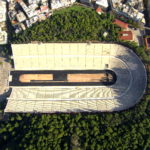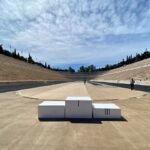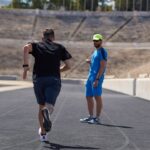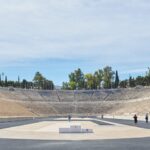1 Hour
Group Tour
English
Up to 10 GUESTS
Running through the history of Athens
Got a Question?
Contact UsHighlights
Running Tour
- Syntagma Square
- Ermou Street
- Monastiraki Square
- Thisseio
- Ancient Agora- Temple of Hephaestus
- Herodus Atticus
- Acropolis – Parthenon – Erechtheion
 Acropolis Museum
Acropolis Museum- Temple of Zeus – Arch of Hadrian
- Zappeion Mansion
- National Garden
- Old Olympic Stadium
Itinerary
Join us for an exhilarating running tour that weaves through the ancient streets and landmarks of Athens, offering a blend of historical intrigue and urban energy. Whether you’re a seasoned marathoner or a casual jogger, this tour is designed to captivate with stories, sights, and the spirit of Greece!
Our journey begins at the vibrant heart of Athens in Syntagma Square, where history meets modernity. Feel the pulse of the city as you run along Athens’ premier shopping street, bustling with life and local flavors, Ermou Street.
Experience the eclectic energy of Monastiraki, with its mix of historic mosques, neoclassical architecture, and the flea market at Monastiraki Square. Run along scenic paths through Thisseio, offering stunning views of the Acropolis towering above, with the Ancient Agora spread out below. Take views of the Temple of Hephaestus, one of the best-preserved ancient temples in Greece, standing proudly since the 5th century BC.
Challenge yourself with a run past Athens’ iconic landmark, the Acropolis. Enjoy brief photo stops to capture the majestic Parthenon and the intricate Erechtheion. Pass through the Acropolis Museum and continue your route to catch glimpses of the monumental Temple of Zeus and Arch of Hadrian, which stand as testaments to the architectural brilliance of ancient civilizations.
Enjoy a gentle run through Zappeion and the lush greenery of the National Garden, right in the city’s center. Conclude your tour at the Old Olympic Stadium, where the first modern Olympics were held in 1896, standing as a testament to the enduring legacy of athletic excellence.
This guided running tour not only promotes physical health but also provides a deeper connection to the rich tapestry of Athens’ history. Lace up your running shoes, bring your curiosity, and prepare for an adventure that runs through the core of ancient greatness!
Please note that the pace of the run will be adjusted to the group’s level on the day.
Inclusions - Exclusions
Inclusions:
- Professional Trainer
- Entrance ticket to the Old Olympic Stadium
- Bottled water
Exclusions:
- Private Transportation
History
The Changing of the Guard:
Although the guards change hourly, there is a big ceremony once a week. These guards, the Evzones, stand motionless at the tomb of the Unknown Soldier. Getting into this unit is an honor and they have to be over 6 ft. tall. They wear white tights, a white skirt, a white blouse with full sleeves, an embroidered vest, red cap and shoes with big pom-poms, but don’t let the outfit fool you, these guys are the best of the best. The uniform is based on the clothing of the Klephts, mountain fighters who fought the Turks from the 15th century until Greek independence in the 19th century.
The Academy of Science:
The Academy building constitutes one of three parts in an “architectural trilogy”. It was founded with the Constitutional Decree of March 18th, 1926, as an Academy of Sciences, Humanities and Fine Arts. The same Decree appointed its first members, who were all eminent representatives of the scientific, intellectual and artistic circles of that era. Designed in 1859, by the Danish architect Theophil Hansen (1813-1891, the younger brother of the University’s architect, Christian Hansen). It is considered the most important work of Hansen and is regarded by some experts as the most beautiful neoclassic building worldwide. The architect’s source of inspiration was the classical architecture of 5th century B.C.E. Athens, as portrayed in the monuments of the Acropolis. In particular, Hansen imitated the Ionian rhythm that dominates the building of the Academy, from the Erechtheion monument. The essence of all ancient Greek tradition can be found in the building’s sculptural and pictorial decoration; simultaneously the character of that era’s Hellenism and its visions for the future are also expressed.
The University of Athens:
The National and Kapodistrian University of Athens is the largest state institution of higher learning in Greece and among the largest universities in Europe. The splendid Athens University was designed by the Danish architect Christian Hansen and completed in 1864. It was the first of the Architectural Trilogy to be built. It still serves as the university’s administrative headquarters. To its left is the Athens Academy, unfortunately, neither is open to the public.
The National Library:
The National Library of Greece was built at the end of the 19th century, as the last of the Architectural Trilogy of Athens, a group of three neoclassical buildings which also includes the Academy and the University. The building was designed by Theophil Hansen, a Danish architect who had studied classical architecture in Vienna and Athens. (He had also previously worked on the University – together with his older brother Christian, as well as on the Zappeion and the Academy of Athens). Construction of the National Library started in 1887 and was completed 15 years later. Theophil Hansen died in 1891 and would never see his building completed. The National Library was designed as a Doric temple flanked by two wings and built almost entirely with Pentelic marble. The design of the Doric building was based on that of the Propylaea on the Acropolis. (It is devoid of any sculptural ornamentation; even the tympanum is left undecorated). Two wide winding staircases lead to the entrance of the “temple”. The statue standing between the staircases shows one of the benefactors of the library, the merchant Panaghis Athanassiou Vallianos. The building houses a large collection of books, maps, newspapers, and manuscripts in Greek and other languages. Most interesting is the collection of Greek manuscripts, some of which are more than 1400 years old.
The Temple of Zeus:
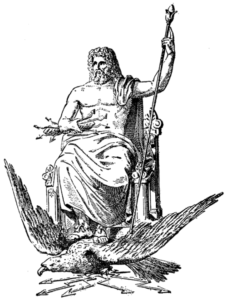 This marvel is right in the center of Athens. It is the largest temple in Greece. Its building began in the 6th century BCE by Peisistratos (but it was abandoned for lack of funds). Various other leaders attempted to finish it, but it was left to Hadrian to complete the work in AD 131 – taking more than 700 years in total to build. The temple is impressive for the sheer size of it. Originally it had 104 Corinthian columns (17 m high and with a base diameter of 1.7 m). Unfortunately, only 15 remain (the fallen one was blown down in a gale in 1852). Hadrian also put up a colossal statue of Zeus (in the cella) and because he was such a modest fellow he placed an equally large one of himself next to it.
This marvel is right in the center of Athens. It is the largest temple in Greece. Its building began in the 6th century BCE by Peisistratos (but it was abandoned for lack of funds). Various other leaders attempted to finish it, but it was left to Hadrian to complete the work in AD 131 – taking more than 700 years in total to build. The temple is impressive for the sheer size of it. Originally it had 104 Corinthian columns (17 m high and with a base diameter of 1.7 m). Unfortunately, only 15 remain (the fallen one was blown down in a gale in 1852). Hadrian also put up a colossal statue of Zeus (in the cella) and because he was such a modest fellow he placed an equally large one of himself next to it.
Hadrian’s Arch:
The Roman emperor Hadrian had a great affection for Athens. Although he did his fair share of spiriting its classical artwork to Rome, he also embellished the city with many monuments influenced by classical architecture. His arch is a lofty monument of Pentelic marble that stands where busy Leoforos Vasilissis Olgas and Leoforos Vasilissis Amalias meet. Hadrian erected it in AD 132, probably to commemorate the consecration of the Temple of Olympian Zeus. The inscriptions show that it was also intended as a dividing point between the ancient and Roman city. The northwest frieze reads ‘This is Athens, the ancient city of Theseus’, while the southeast frieze states ‘This is the city of Hadrian, and not of Theseus’.
The Old Olympic Stadium / Panathenaic Stadium:
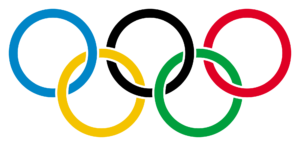 The grand Panathenaic Stadium lies between two pine-covered hills (between the neighborhoods of Mets and Pangrati). It was originally built in the 4th century BCE as a venue for the Panathenaic athletic contests. It’s said that at Hadrian’s inauguration in AD 120, 1000 wild animals were sacrificed in the arena. Later, the seats were rebuilt in Pentelic marble by Herodes Atticus. There are seats for 70,000 spectators, a running track and a central area for field events. After hundreds of years of disuse, the stadium was completely restored in 1895 (by a wealthy Greek benefactor Georgios Averof) to host the first modern Olympic Games the following year. It’s a faithful replica of the original Panathenaic Stadium. It made a stunning backdrop to the archery competition and the marathon finish during the 2004 Olympics. It’s occasionally used for concerts and public events, and the annual Authentic Athens Marathon finishes here.
The grand Panathenaic Stadium lies between two pine-covered hills (between the neighborhoods of Mets and Pangrati). It was originally built in the 4th century BCE as a venue for the Panathenaic athletic contests. It’s said that at Hadrian’s inauguration in AD 120, 1000 wild animals were sacrificed in the arena. Later, the seats were rebuilt in Pentelic marble by Herodes Atticus. There are seats for 70,000 spectators, a running track and a central area for field events. After hundreds of years of disuse, the stadium was completely restored in 1895 (by a wealthy Greek benefactor Georgios Averof) to host the first modern Olympic Games the following year. It’s a faithful replica of the original Panathenaic Stadium. It made a stunning backdrop to the archery competition and the marathon finish during the 2004 Olympics. It’s occasionally used for concerts and public events, and the annual Authentic Athens Marathon finishes here.
Cancellation Policy

All cancellations must be confirmed by Olive Sea Travel.
Regarding the Day Tours:
Cancellations up to 24 hours before your service date are 100% refundable.
Cancellation Policy:
- Licensed Tour Guides and Hotels are external co-operators & they have their own cancellation policy.
- Apart from the above cancellation limits, NO refunds will be made. If though, you fail to make your appointment for reasons that are out of your hands, that would be, in connection with the operation of your airline or cruise ship or strikes, extreme weather conditions or mechanical failure, you will be refunded 100% of the paid amount.
- If your cancellation date is over TWO (2) months away from your reservation date, It has been known for third-party providers such as credit card companies, PayPal, etc. to charge a levy fee usually somewhere between 2-4%.
- Olive Sea Travel reserves the right to cancel your booking at any time, when reasons beyond our control arise, such as strikes, prevailing weather conditions, mechanical failures, etc. occur. In this unfortunate case, you shall be immediately notified via the email address you used when making your reservation and your payment WILL be refunded 100%.


